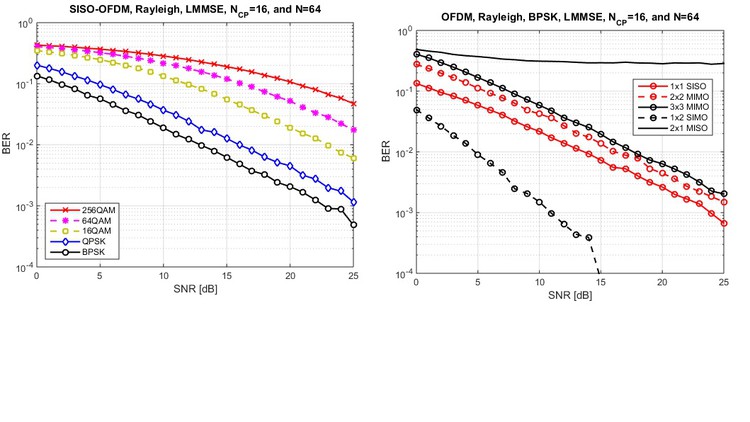
A step by step the Matlab codes for BER estimations of different Comm. systems like OFDM and NOMA Comm. systems
What you will learn
How to estimate the Bit-Error-Rate (BER) performance of different modulation schemes like BPSK, QPSK, 16QAM, 64QAM, and 256QAM over an Additive White Gaussian Noise (AWGN) channel?
How to generate and add a Rayleigh fading channel based on the Jakes model?
How to mitigate the Rayleigh fading channel effect using different linear equalizer schemes?
How to estimate the Bit-Error-Rate (BER) performance over Single-Input-Single-Output Orthogonal Frequency Division Multiplexing (SISO-OFDM) communication system over a Rayleigh fading channel?
How to extend this work for different Multiple-Input-Multiple-Output (MIMO) configurations like 2×2, and 3×3 MIMO-OFDM communication systems over a Rayleigh fading channel?
A general code for BER estimation in case of Nt×Nr configuration for OFDM communication system over a Rayleigh fading channel will be presented, where Nt, is the number of transmitting antennas, and Nr is the number of receiving antennas.
Finally, the BER estimation for Non-Orthogonal Multiple Access (NOMA), which used in the 5G communication systems will be presented.
Add-On Information:
Note➛ Make sure your 𝐔𝐝𝐞𝐦𝐲 cart has only this course you're going to enroll it now, Remove all other courses from the 𝐔𝐝𝐞𝐦𝐲 cart before Enrolling!
- Course Overview
- This specialized MATLAB course is meticulously designed for aspiring and practicing wireless communication engineers seeking to master the simulation and performance analysis of modern wireless systems.
- It moves beyond theoretical concepts, providing a robust, hands-on framework for understanding and evaluating the critical performance metric: Bit Error Rate (BER).
- Dive deep into the practical implementation of various digital modulation schemes and their behavior under realistic channel conditions, including the ubiquitous Additive White Gaussian Noise (AWGN) and the challenging Rayleigh fading.
- Explore advanced communication paradigms such as Orthogonal Frequency Division Multiplexing (OFDM) and Multiple-Input Multiple-Output (MIMO) systems, forming the backbone of current and future wireless standards.
- Gain insights into the impact of channel impairments and the efficacy of different mitigation techniques, solidifying your understanding of system design trade-offs.
- The course emphasizes a systematic, code-centric approach, enabling you to build, test, and optimize wireless communication links from the ground up within the MATLAB environment.
- Requirements / Prerequisites
- Fundamental Understanding of Digital Communications: Familiarity with concepts like modulation, demodulation, noise, bandwidth, and basic link budget analysis.
- Basic MATLAB Proficiency: Ability to write simple scripts, understand arrays, loops, and functions. Prior exposure to signal processing toolboxes is a plus but not strictly required.
- Elementary Probability and Statistics: A grasp of random variables, probability density functions, and statistical averages will aid in comprehending BER estimation.
- Signal Processing Basics: Knowledge of time-domain and frequency-domain representations, filtering, and sampling concepts.
- Skills Covered / Tools Used
- MATLAB Programming for Wireless Communications: Develop proficiency in crafting efficient and scalable MATLAB code specifically for communication system simulations.
- Channel Modeling and Impairment Simulation: Learn to accurately model real-world wireless channels, including AWGN, Rayleigh fading, and other propagation effects.
- Performance Analysis Techniques: Master the methodologies for estimating and interpreting BER, SNR, and other key performance indicators.
- Advanced System Simulation: Gain expertise in building comprehensive simulation models for complex systems like OFDM, MIMO, and NOMA from first principles.
- Data Visualization and Interpretation: Effectively plot simulation results (e.g., BER curves) to draw meaningful conclusions about system performance.
- Debugging and Optimization of Communication Codes: Acquire practical skills in identifying and resolving issues in complex simulation environments.
- Benefits / Outcomes
- Hands-on Expertise in Wireless System Simulation: Develop the practical ability to simulate, analyze, and optimize advanced wireless communication systems using industry-standard tools.
- Deeper Understanding of Channel Impairments: Gain profound insights into how noise and fading impact system performance and how to effectively counteract them.
- Foundation for Advanced Research and Development: Equip yourself with the necessary skills to pursue further studies, contribute to R&D projects, or innovate in the wireless industry.
- Enhanced Problem-Solving Capabilities: Learn to approach complex wireless communication challenges with a simulation-driven, analytical mindset.
- Career Readiness: Position yourself competitively for roles in telecommunications, academia, or defense sectors requiring strong wireless simulation and analysis skills.
- PROS
- Highly Practical and Application-Oriented: Directly translates theoretical knowledge into tangible, working simulations.
- Strong Foundation for 5G/6G Technologies: Provides essential building blocks for understanding and developing next-generation wireless systems.
- In-demand Skillset: Proficiency in MATLAB for wireless communication simulation is a valuable asset in the current job market.
- Empowers Independent Research: Gives participants the tools to design, test, and evaluate their own innovative communication algorithms.
- Step-by-Step Approach: Ensures a clear learning path, making complex topics accessible to learners.
- CONS
- Platform Specificity: While powerful, the heavy reliance on MATLAB means the specific code might not be directly transferable to other simulation platforms without adaptation.
English
language